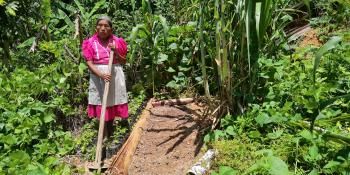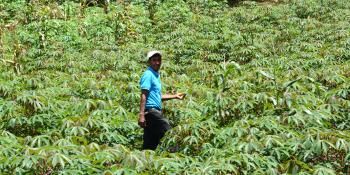Leveraging climate information services to help farmers cope with climate change in Africa
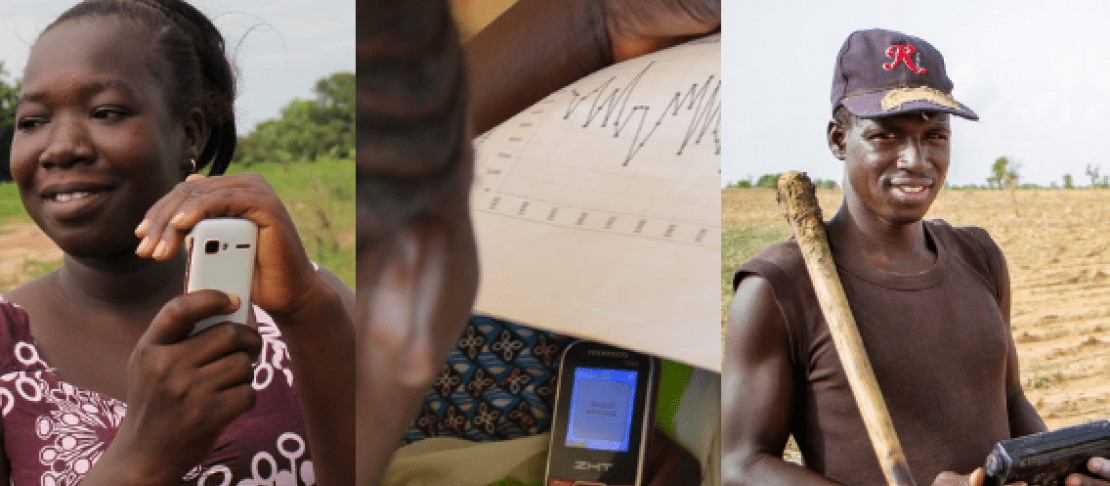
We celebrate World Development Information Day by highlighting CCAFS' work on climate information services in Africa.
Information and communications technologies have the potential to provide new solutions to development challenges, particularly in the context of globalization, and can foster economic growth, competitiveness, access to information and knowledge, poverty eradication and social inclusion."
UN General Assembly Resolution (A/RES/65/141)
Read about our Climate Services and Safety Nets Flagship program.
Efforts to design services that meet the needs of farmers and the institutions that support them can build on a rich body of knowledge and experience. Yet critical gaps in knowledge, information, methodology, and evidence must be addressed if these services are to contribute to scaling up climate-smart agriculture.
In this blog, we highlight how CCAFS research and engagement work around climate information services in Africa helps smallholder farmers to cope with climate change.
Pathways for gender-sensitive communication channels in climate services
Access to climate information is integral to effective agricultural decision-making. Yet gender-based differences in schooling received and in access to communication channels (i.e. group processes, media and ICTs) exist. This results in women and men experiencing differing access to critical weather and climate information, often to women’s disadvantage. Recommendations to address these issues focus on identifying context- and gender-specific needs and fostering local connections to establish enhanced communication channels. While differences in capacities to act on weather and climate information require critical consideration as well, addressing gender-based challenges to accessing communication channels can be a key step to achieving gender-responsive climate services.
Read more:
- Info note: Identifying Pathways for More Gender-Sensitive Communication Channels in Climate Services
- Poster: Exploring pathways for gender-responsive climate services in Rwanda
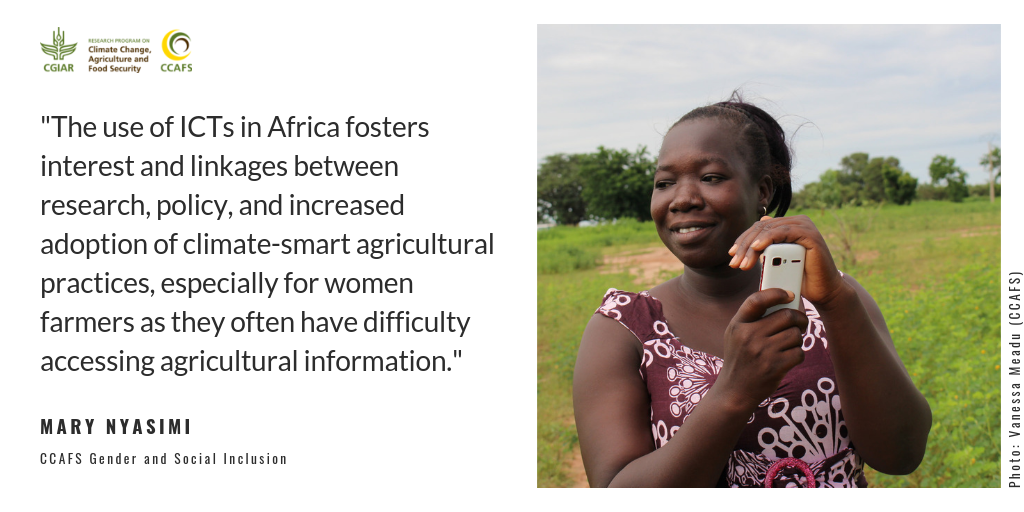
Improving women’s access to climate information services in Ghana
In Ghana, CCAFS initiated a pilot project aimed at disseminating sustainable and equitable climate information services to farmers through mobile phone platforms for strategic farm management decisions that help them adapt to climate change and variability.
A recently published CCAFS paper, "Gender and climate risk management: evidence of climate information use in Ghana," suggests that the design of climate information services must consider gender-specific needs, including by exploring various dissemination channels that address the constraints experienced by women, to ensure the development of a gender-responsive decision support service. By improving women’s access to and use of climate information services, they can play important roles in household climate change adaptation planning. The study also recommends the mainstreaming of gender in agricultural policies to foster women’s equal access to farm resources.
Closing the gap between climate information producers and users in Senegal
In Senegal, various adaptation techniques are being used such as drought-resistant crop varieties, soil and water conservation techniques, traditional pruning and fertilizing techniques, different planting dates, agroforestry and assisted natural regeneration systems. More recently, important investments have been deployed to enable the national body in charge of meteorological data management to produce and disseminate required climate information services and to train users to understand and efficiently integrate climate information services into their management systems.
Read this recently published journal article on the approaches used to engage producers in the uptake of climate information services in Senegal: Closing the Gap between Climate Information Producers and Users: Assessment of Needs and Uptake in Senegal
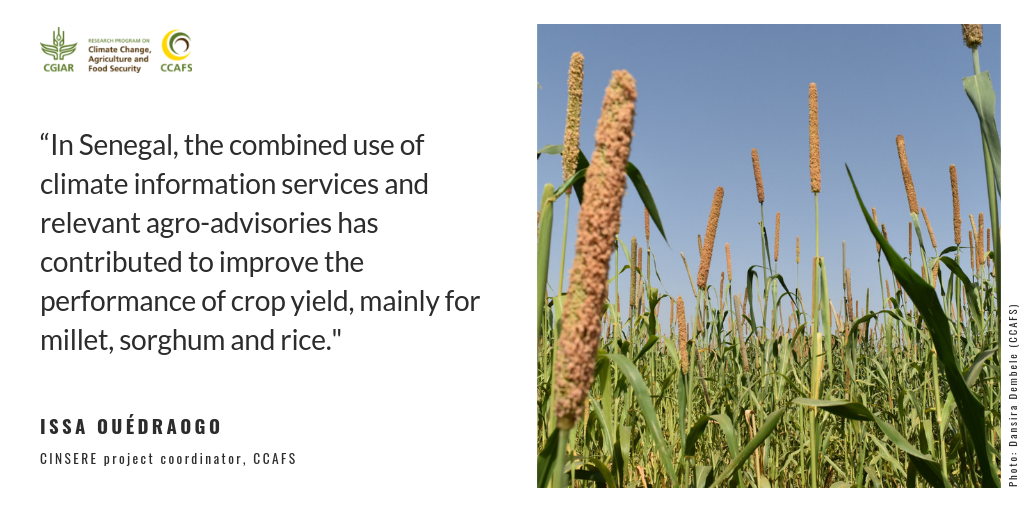
Building climate services capacity in Rwanda
As part of our Rwanda Climate Services for Agriculture project, agricultural extension and other relevant intermediary organizations and communicators (e.g. farmer cooperatives, rural radio networks, ICT providers, NGOs) provide farmers across Rwanda’s 30 districts with decision-relevant, operational climate information and advisory services, and train them to use the information to better manage risk.
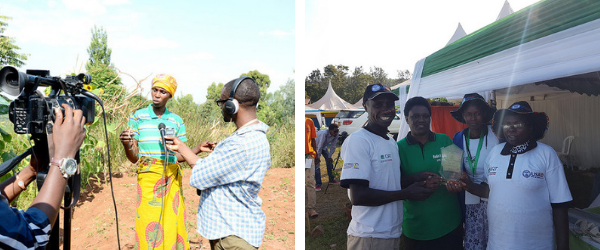 | |
| Open Field Day in Bugesera District, Rwanda 19-20 June 2018. The Rwanda Climate Services for Agriculture project organized the event for farmer promoters (trained farmers) to share with their fellow farmers on the lessons and practices learned from climate services training. Photo: T. Muchaba (CCAFS) | Radio Huguka, one of the Rwanda Climate Services for Agriculture project partners, has recently won the Best Media Exhibitor Award at the 13th National Agriculture Show in Rwanda. The radio has a substantive following of about 4 million listeners, of whom more than 70% are agricultural producers. Photo: Y. Munyangeri (CIAT) |
Enhancing National Climate Services (ENACTS)
Enhancing National Climate Services (ENACTS) is an ambitious effort, developed by the International Research Institute for Climate and Society (IRI), to enable National Meteorological Services (NMS) to improve the availability, access and use of climate information. Gaps in historical climate records, in space and time, are filled by merging quality-controlled station data with high-resolution data from satellite remote sensing, climate models and digital elevation maps.
Recognizing the urgent need for more locally relevant climate information, for managing risk and adapting to change, CCAFS has supported and leveraged the ENACTS approach in several countries in Africa, and in its work with regional climate centers in East and West Africa.
With CCAFS' support, five African National Meteorological Services (Rwanda, Senegal, Ethiopia, Mali, Madagascar) and two regional climate centers (ICPAC and AGRHYMET) routinely provide advanced, high-resolution growing season information and analyses designed to support farmers and other agricultural decision-makers.
Rwanda and the regional climate centers have introduced new downscaled climate forecast Maprooms that are beginning to revolutionize how seasonal forecasts are presented and communicated. The process has elevated the capacity and status of collaborating National Meteorological Services, enabling them to provide information at a national scale—collectively serving a rural population of 125 million—that was previously feasible only at a pilot scale through costly manual analyses of available station records.
Read more about the Maprooms in this blog: Improving availability, access to and use of climate information in Ethiopia
Interventions that are effective at a pilot scale once seemed impossible to scale out to locations that lack long-term climate records. The custom analysis of daily station records seemed prohibitively costly for a developing country National Meteorological Services to scale up across a country. ENACTS is overcoming long-standing obstacles to providing climate services that are tailored to farmers’ local needs, at a national scale.”
Jim Hansen, CCAFS Climate Services and Safety Nets Flagship Leader
Read more about ENACTS:
- Blog: Developing user-centric climate services to enhance drought resilience in Africa
- Blog: Rwanda establishes a national framework for climate services
- Report: Training on ENACTS Data Library and Maproom software
- Report: Advancing the use of gridded, online climate information for risk management in the Horn of Africa
Agricultural advisory services at a global scale
Effective climate information and advisory services for farmers, and climate-informed safety net interventions will enable farmers in environments prone to climate risk around the world to transition towards more climate-smart agricultural systems and climate-resilient livelihood strategies while protecting their livelihoods from climatic extremes.
But how do we ensure farmers have access to reliable and relevant climate information?
Reaching half a billion farmers in 10 years using old methods is impossible. In a decade each farmer needs to have access to a mobile phone. We envision a system where a farmer takes a photo of a problem crop, submits it to the Internet, and receives an instant answer that is relevant to her farm, to the inputs that she can access, and to the market conditions. In a local language. We have to have this vision if we are going to reach half a billion farmers. And we are sure that through big data analytics and decision support algorithms this can be achieved."
Source: CCAFS blog written by Bruce Campbell, Philip Thornton, Dawit Solomon, Svend Christensen and Ishmael Sunga
Lili Szilagyi is the Communications Consultant for CCAFS East Africa.

